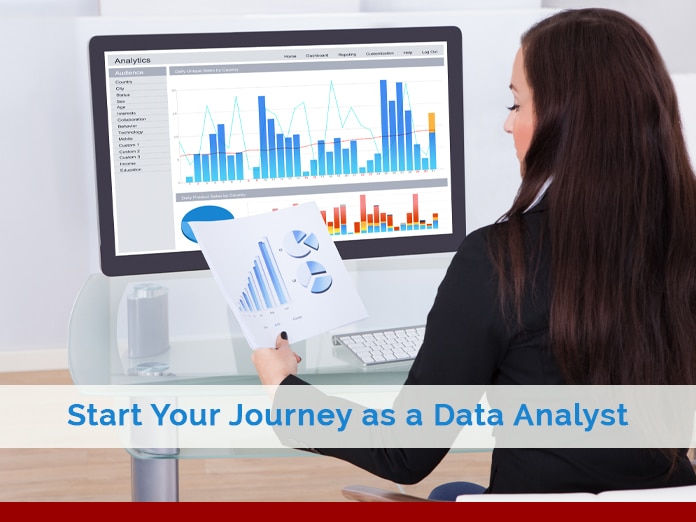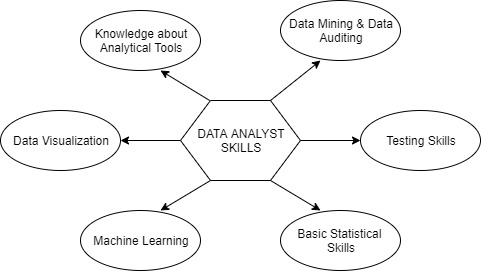In today’s blog, we discuss not only data science, but also, starting one’s journey as a data analyst.
It discusses particularly (1) How to become a data analyst? and (2) What is the process and eligibility to become a data analyst?
Jump to Section
Introduction
First, let’s discuss the data analyst job, its role, and its responsibilities. Data analyst, a person who analyses the data as the name says. There are various types of specific data analyst profiles such as business analyst, health analyst, market analyst and much more. Accordingly, the name of the analyst depends on the field they work in and the type of data they handle.
At Loginworks, we work with different types of data from different industries such as health, market, sports, business, and many more. A lot of challenges we face with different fields of data. We perform ETL, we extract and collect the data, we clean and model the unstructured data and load the data from different sources to the tools. After ETL we analyze and visualize the data using the business intelligence tool, and creates dashboards and reports to makes it easier to detect patterns, trends, and outliers hidden in data. Presenting complicated datasets to an attractive dashboard makes it easy for the audience to understand the clear and concise data information better.
Requirements
Indeed basic skills that a data analyst must possess: data mining, R or Python, SQL, statistical analysis, and data analysis.
- To analyze the data you must have a better knowledge of statistics, to see and detect the patterns and outliers of the data, statistical knowledge helps you use the proper methods to collect the data. Statistics is important to derive meaningful insights from data by performing mathematical computations on it. Statistics help to interpret data to make decisions based on data and make predictions.
- Your maths should be good enough to acquire this job as the core language of analysis data is numbers, you have to perform different mathematical operations, like linear algebra, algebraic expressions and solve equations. You will need to be able to graph different types of functions and relate the graph with the equations.
- You should have a basic knowledge of machine learning. It is a method of data analysis that automates analytical model building that performs a specific task without using explicit instructions.
- You should be proficient in Microsoft Excel, as, for smaller analytics, it is very useful with the inbuilt tools like VBA. Different types of functions are there in Excel which is really useful to manipulate and model the data.
- At least one should learn one business intelligence tool, which can be used for data visualization. There are many tools that you can learn easily and they even provide you the trial period, therefore one needs not buy it initially.
- You should have knowledge of SQL to understand the database and operate the data writing the SQL queries.
Machine Learning
Machine learning is pure calculus and linear algebra with statistics, the study of algorithms and comprising statistical models.
- There are two basic machine learning algorithms:
- Supervised algorithms like Linear Regression, Logistic Regression, KNN classification, Support Vector Machine (SVM), Decision Trees, Random Forest, Naive Bayes’ theorem.
- Unsupervised algorithms like K Means Clustering, Principal Component Analysis (PCA).
Programming Requirements
All this is okay to start with your career as a data analyst, but only when you’re using business intelligence tools. If you’re not from a programming background. To grow and bloom much in this field you should have programming skills too like R and Python.
- You should be proficient in at least one programming language. However, the more programming language you know the better it is.
- R Programming: R is used as a statistical platform for data cleaning, analysis, and representation.
- Python Programming: Python is a programming language oriented towards data science. It has vast libraries for data analysis. We can import, manipulate, and analyze the data very smoothly.
- Learning both of the languages is best as R is used best for statistical computation and Python is good for data science general approaches like data modeling.
For the very basic you should have a bachelor’s degree in information technology, computer science, or statistics at least and if you are from the non-technical background you should have diploma or certification in this data science field.
Learning Sources
There are a lot of online tutorials available for the data science courses on Google and as well as on Youtube. Especially, you can get the online certification for the data science course from the different education hub website. Of course, certification is mostly paid but learning is free at some sites. There are also free tutorials for separate topics you can get following the data science syllabus.
You can visit our site to know more about how we work at Loginworks Softwares Inc.
Feel free to share your feedback and your opinion about this blog in the comment section below. Hope you enjoyed this post.
- Business Intelligence Vs Data Analytics: What’s the Difference? - December 10, 2020
- Effective Ways Data Analytics Helps Improve Business Growth - July 28, 2020
- How the Automotive Industry is Benefitting From Web Scraping - July 23, 2020


